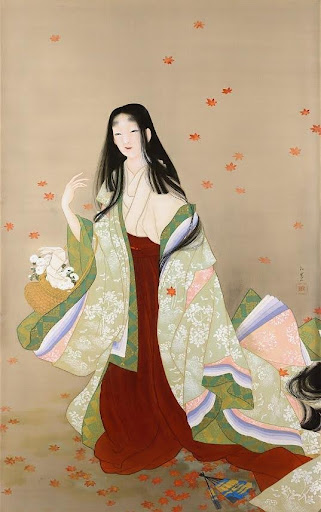8.花がたみ(Hanagatami)
異色かつ重要な位置を占める作品

《花がたみ》は、謡曲『花筐(はながたみ)』に登場する女性「照日前(てるひのまえ)」を主題に1915年に描いた作品。かつて愛された皇子が天皇となり、自分のもとを去った後、狂女となって都に現れ、舞を通して愛の記憶と喪失を訴えるという物語に基づいている。着物の乱れや虚ろな表情、足元の落ちた扇などから、彼女の精神的な混乱と深い悲しみが伝わってくる。松園はこの狂女の姿を描くため、祇園の芸妓に舞を再現させて写生を行い、さらに京都・岩倉の精神病院に通って実際の患者の表情や動作を観察している。着物には秋草や流水文様が丁寧に描かれ、繊細さと狂気の対比が際立っている。花籠は愛の象徴であり、照日前の狂気と哀しみを象徴する重要なモチーフとして表現されている。女性の内面を描こうとした異色かつ重要な位置を占めている作品である。
Hanagatami (Flower Basket)
A distinctive and pivotal work
Painted in 1915, Hanagatami is based on the Noh play Hanagatami, which features the character Teruhi-no-Mae. Once loved by a prince who later became emperor, she is abandoned and reappears in the capital as a madwoman, performing a dance to express her memories of love and the pain of loss.
Her disheveled kimono, vacant expression, and the fallen fan at her feet convey psychological confusion and deep sorrow. To depict this figure, Uemura had geisha from Gion reenact the dance for sketching, and she visited a psychiatric hospital in Kyoto’s Iwakura district to observe the expressions and movements of actual patients.
The kimono is adorned with autumn grasses and flowing water motifs, highlighting the contrast between delicate beauty and madness. The flower basket, a symbol of love, becomes a key motif representing Teruhi-no-Mae’s madness and grief.
This work stands out as a unique and significant attempt to portray the inner psyche of a woman through painting.
お問い合わせ
〒154-0024 東京都世田谷区三軒茶屋1-39-7